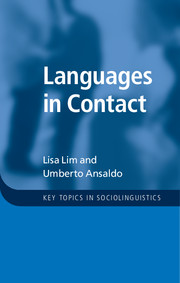Book contents
- Frontmatter
- Contents
- List of figures
- List of tables
- Preface
- Acknowledgements
- List of abbreviations
- 1 Perspectives on contact
- 2 Contact and code choice
- 3 Contact and creole formation
- 4 Contact and language evolution
- 5 Contact and ecology
- 6 Contact and shift
- 7 Contact and globalisation
- 8 Reflections and future directions
- References
- Index
Preface
Published online by Cambridge University Press: 05 November 2015
- Frontmatter
- Contents
- List of figures
- List of tables
- Preface
- Acknowledgements
- List of abbreviations
- 1 Perspectives on contact
- 2 Contact and code choice
- 3 Contact and creole formation
- 4 Contact and language evolution
- 5 Contact and ecology
- 6 Contact and shift
- 7 Contact and globalisation
- 8 Reflections and future directions
- References
- Index
Summary
On a little dot of a tropical island in Southeast Asia just above the equator, a decade and a half ago, the Department of English Language and Literature of the National University of Singapore witnessed an encounter between two colleagues, one newly hired. Neither imagined that that contact would lead to any output of substance or significance, for the simple reason that they came from very different academic backgrounds and had, at that point, minimal knowledge or interest in the other's fields. One had trained as a phonetician and was working on a New English in the World Englishes paradigm. The other was a creolist and typologist specialising in Sinitic varieties. A standing joke was that we would never be talking about work when we got together outside office hours, so distinct and compartmentalised were our interests and expertise.
This ontological anecdote underlines the essence of this book. The studies of pidgin and creole languages on the one hand and World Englishes on the other are almost always written about as separate animals; an exception is John Platt, whose writing in the 1970s and 1980s did integrate the study of New Englishes with pidgin and creole studies, as is, more recently, Bao Zhiming. One primary aim of this book was indeed to bring our collective expertise in our respective fields together in an integrated view, such that what is common and com-parable in the sociolinguistic factors and structural processes involved in the evolution of contact varieties – whether creoles, New Englishes or mixed codes – might be recognised. Our discussions in the early years planted the seed. Half a dozen years at the University of Amsterdam and the Amsterdam Centre for Language and Communication – in particular our engagement with colleagues in the Language Creation and the Sociolinguistics and Multilingualism groups and other scholars in Europe and the US, who were doing critical, cutting-edge research – profoundly influenced our thinking, especially in developing an ana-lysis of New Englishes from a contact perspective. That being said, it might still appear surprising to the reader that it is a mere two chapters that appear to be dedicated to pidgin and creole languages and linguistics, these being the cornerstone of the study of languages in contact, when the majority of books in the field usually devote themselves entirely to them.
- Type
- Chapter
- Information
- Languages in Contact , pp. ix - xPublisher: Cambridge University PressPrint publication year: 2015



